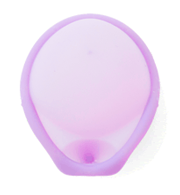Inserting a diaphragm may seem difficult, but it just takes a bit of practice to get it right. If you’re using a Milex diaphragm, your provider will show you how to do it when you see them to get your prescription. If you’re using Caya, a visit to your provider is optional, but they can check the fit and help you learn how to put it in and take it out.
The diaphragm can be inserted just before sex, but it can also go in up to one hour before you have sex, which means it doesn’t have to interrupt the moment. (Just remember that if you’re still having sex or haven’t started having sex yet, and it has been more than an hour since you put in the diaphragm, you’ll need to put more spermicide into your vagina.)
But no matter when the diaphragm and spermicide go in, you have to leave the diaphragm in for at least six hours after the last time you have sex in order for it to work correctly. If you’re going to have sex again before taking it out (no matter how much time has passed since you last had sex, even if it’s only been a few minutes), leave the diaphragm in place and insert more spermicide way up in your vagina, following the applicator instructions that come with it. Just make sure not to leave your diaphragm in for more than 24 hours at a time, or use it during your period, because that can lead to toxic shock syndrome, a dangerous condition caused by an infection.
_How to put in your diaphragm:_
1. Wash your hands well with soap and water.
2. Check your diaphragm for holes and weak spots. You can check by filling it with water—if it leaks, that means it has a hole in it somewhere. If water can get through, sperm will be able to get through too, so use a different method of birth control, like condoms, until you can replace your diaphragm.
3. Holding the diaphragm in your hand so it’s facing up, like a little bowl, add about a teaspoon of spermicide to the inside of the bowl. Spread a little spermicide around the rim as well. Any kind of spermicide will do, except for the film or suppository types. You can use [over-the-counter spermicide](/over_the_counter_spermicide) or [prescription-only spermicide (Phexxi)](/Prescription_only_spermicide_Phexxi). As with any kind of birth control, don’t forget to check the expiration date. It may not work if it’s expired.
4. Get comfy, like you’re going to put in a tampon or menstrual cup. Some people like to put one leg up on the toilet seat cover, while others find that squatting gives them the best access.
5. Put your index and middle fingers into your vagina and feel for your cervix, so you’ll know where to place the cap. Your cervix will feel sort of hard but squishy, like the tip of your nose.
6. Separate the lips of your vulva with one hand, and use the other hand to pinch the rim of the diaphragm and fold it in half.
7. Put your pointer finger in the middle of the fold to get a good, firm grip. (Yes, you’ll be touching the spermicide.)
8. Push the diaphragm as far up and back (towards your lower back) into your vagina as you can.
9. Make sure your cervix is totally covered. You can check that the diaphragm is in the right place by making sure the front part of the rim is tucked behind your pubic bone. You should also be able to feel your cervix through the material of the diaphragm, so you can make sure the diaphragm is in place that way too.
10. After sex, leave your diaphragm in for at least six hours before taking it out.
_How to take it out:_
1. Wash your hands. (Or some people like to take their diaphragm out in the shower for easy cleanup.)
2. Put your pointer finger inside your vagina and hook it over the top of the rim of the diaphragm or, if you’re using Caya, hook your pointer finger under the edge of the smaller removal dome.
3. Pull the diaphragm down and out.
4. After you take it out, wash it with mild soap and warm water. DON’T boil it, and never use powders or oil-based lubricants (like Vaseline or cold cream) on your diaphragm.
5. Let it air dry.
6. Pop it back in its case to use again next time you have sex.
_Tips for making it work:_
1. You can use lube with your diaphragm, but only use the water-based kind.
2. If you have sex again within six hours, insert more spermicide first---no matter how many times you have sex during the six-hour time period. Most types of spermicide will come with an applicator that allows you to insert it high up into your vagina, close to your cervix. That’s where you want it to be. The six-hour clock starts over again every time your partner ejaculates in your vagina or on your vulva.
3. You can carry out your normal activities, including going swimming, going in a hot tub, and taking a bath, with your diaphragm in.
4. If you have vigorous sex, check to make sure your diaphragm is still in place afterward. If it isn’t still in place, but your partner didn't ejaculate, you can just add more spermicide and put your diaphragm back in. If your partner did ejaculate, and then you find that your diaphragm was out of place, using [emergency contraception](
https://www.bedsider.org/birth-control/emergency_contraception) can help you prevent pregnancy.
5. Don’t use the diaphragm when you have your period. It can lead to toxic shock syndrome.
6. Don’t leave the diaphragm in for more than 24 hours.


